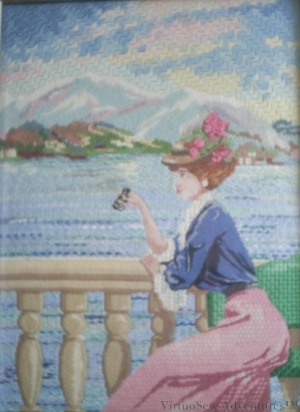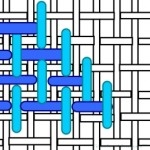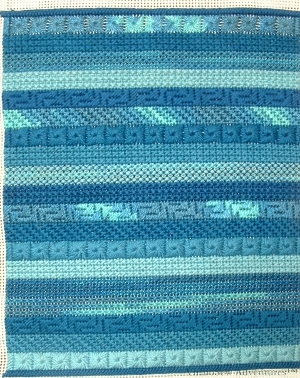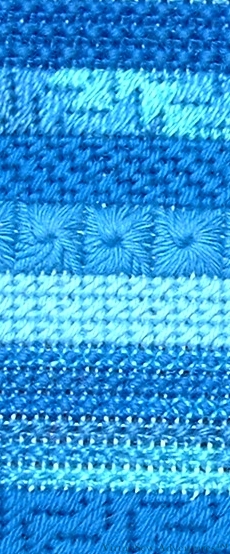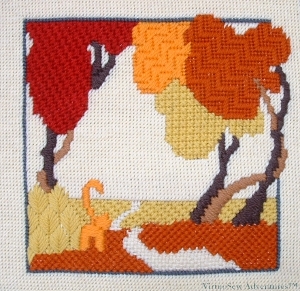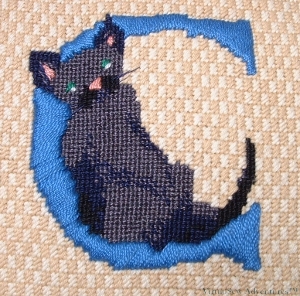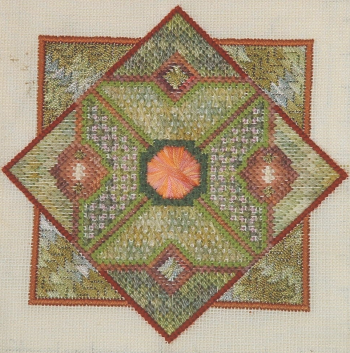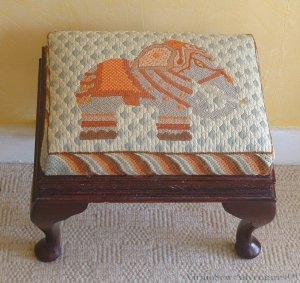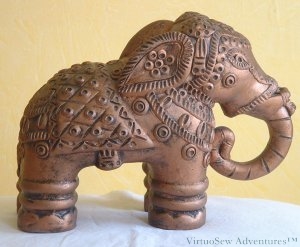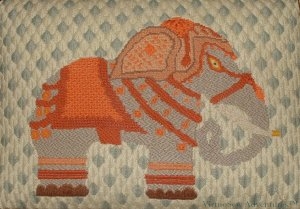Category: Needlepoint
The Lady By The Lake – another early project
This was another early project. It was a DMC painted canvas, which was clearly intended to be done in tent stitch using tapestry wool. As it is eighteen inches by nearly two feet, that would have driven me wild…
I bought it almost entirely because I thought I could see a way to get the folds in the dress to appear the right shades without using as many colours of thread, and I wanted to experiment. So I used a bordered Hungarian Stitch, worked in three shades of pearl cotton and combining them to create the impression of five shades in the skirt. It worked!
The blouse is also pearl cotton, this time Linen Stitch, which is effectively the back of Basketweave Tent stitch put on the front. It produces a very solid, durable background and I’ve used it on cushion projects in the past.
The only drawback is that it takes so long to do. I’ve diagrammed it here because I can’t find it online, and I’ve found it such a useful stitch myself. It is worked diagonally, just like basketweave tent stitch.
The face and arms were worked in petit point, separating the double threads to create single thread canvas, and worked in stranded cottons (blended). The hair (she didn’t have such glorious chestnut hair on the painted canvas itself) is also blended stranded cottons, worked in a sort of long and short stitch. The hat has spider’s web stitch roses on it.
I changed the wooden, slatted backed bench of the canvas into a padded one so that I could do the upholstery in Reversed Mosaic Stitch. The lake itself took ages to do – row after row of darning stitch using all sorts of ribbons and threads, including some truly ghastly knitting acrylic which would have made a dreadfully uncomfortable jumper, but made a very good lake surface, with that slight sparkle you get when there’s just enough breeze to move the water.
The sky and clouds are all Milanese Stitch, worked in blended Persian yarns with three strands in the needle. It works, but now I’ve read Terry Pratchett I’m afraid it makes me think of the sky above “gnarly ground” in “Carpe Jugulum” – not such a peaceful thought!
Stripes!
This panel of canvaswork was originally intended to make a case for my husband’s beloved Psion palmtop computer. Alas, by the time I finished it, the Psion was no longer working.
The starting point was a wonderful Watercolours thread, graduated in shades of blue (not blue for a boy, blue for a redhead!), to which I added toning shades in soft embroidery cotton. It seems that this thread is not made any more, which I think is a pity. It used to provide a good alternative to tapestry wool, especially for those who don’t like working with wool in the summer, and – provided the right base fabric is chosen – a reasonable heavy but matte thread for surface embroidery. Almost all the threads now available are mercerised, and thus have a slight shine – but sometimes we don’t want any sheen on our stitches at all!
I rotated through several different stitches, as well as the different colours, and made sure that the second layer in the fine Wildflower thread overlaid a different base colour each time. There were five threads (Watercolours plus four soft cotton) and six stitches, which ensured that they cycled round. The stitches I chose were Milanese, Diagonal Mosaic, Eye (not pulled), Mosaic, Rice (using the Wildflowers thread for the second layer of stitches) and Double Cross Stitch.
The full size piece shows how the position of the colour changes is different in each stitch, as well as showing the veiled effect of different colours each overlaid by the variegated thread in the different panels of Rice Stitch. For that reason it is a very interesting needlepoint panel, but I still have a completely finished and neatly-worked canvaswork sampler looking for an occupation!
Canvaswork Inspired by Clarice Cliff
The design in counted cross stitch that I created, “The Cat Who Walked By Himself” (now being re-issued by Classic Embroidery – remember how excited I was a few months ago?) was such a success that I experimented with other ways in which the basic design might be used.
First of all, in ordinary tent stitch at a large size. Pleasant enough, but rather dull – for me, at any rate.
Then, at the same size as the original cross stitch, but using ornamental canvaswork stitches. Originally I had in mind to run classes based on these designs, in one of the local shops, but the shop closed, life changed direction, and I’ve not done anything with it yet.
As I post more of my early canvaswork, you will probably notice some stitches recur. For example, I like Upright Cross Stitch – it is sturdy and heavily textured – and Milanese stitch (I think just because I like the name). I usually sneak in Leaf Stitch as well (remember the Elephant of Considerable Charm?). I’ve also used Jacquard Stitch, and Satin Stitch. The background was worked in Encroaching Gobelin Stitch.
I’ve not put the heavy outlines on yet. Tapestry wool would be too heavy – some of the areas are quite small – but on the other hand, I don’t want to use something that will draw too much attention to itself by being shiny..
C is for Cat
When I saw this as a painted canvas is a needlework shop, it immediately made me think of a friend who had a black cat, so I thought of doing it as a present.
The original canvas showed a seal-point Siamese with blue eyes, so I stretched a few points and used grey and navy to create a black cat that was light enough to show its shape and markings, and gave him green eyes as well. The cat is entirely worked in basketweave tent stitch. Much as I enjoy working the ornamental stitches, sometimes restraint is advisable!
Besides, the bright blue “C” is double padded with soft embroidery cotton and then satin stitched over with pearl cotton. I thought that would be quite dramatic enough without any additional flourishes!
The background is worked as a gentle oblong check in Straight Cashmere Stitch, using two shades of soft embroidery cotton that tone with the velveteen I used to make the cushion it is mounted on. I’d almost forgotten about this panel until I was rummaging for notes of some other embroidery I had done and found a reference to it, so it is gratifying to find that I am still very pleased with it. It was a fairly simple and straightforward design, and I think my choice of stitches and threads was simple enough to reflect that while having enough variation to be interesting.
I’m not sure what the real cat thought of his portrait. Cats are what they had in mind when they came up with the word “inscrutable”!
The Canvaswork Knot Garden
This piece arose from my fascination with the knot gardens and parterres of early formal garden design.
It began with the octagonal Rhodes Stitch at the centre. I wanted to use the stitch, but not as part of a repeating pattern. In fact it proved much more difficult to get right than I was prepared for. I now can’t remember how many times I unpicked that wretched octagon!
From that central point a variety of little paths and beds radiate out, using slightly subdued colours again inspired in particular by the colours of herbs. The variegated threads are all from Stef Francis, pearl and soft cottons, and a chainette (in the corners). The stitches include Hungarian Stitch, cashmere stitch, and upright cross stitch (which for some reason turns up a lot in my canvaswork).
I realised that the interesting stitches I was using weren’t producing complete coverage of the canvas, but I decided not to worry about that, as I felt it might lead to something interesting.
As you can tell, what it has not yet lead to is a sensible finishing decision. I cannot for the life of me decide what to do with this. It would be a pity to put it under glass, as that wonderful raised boss of the octagon would lose all of its impact. At the same time, because the coverage is so varied, and because the octagon is such a vulnerable point, turning it into a cushion seems positively half-witted.
Take heed, and design your pieces with their end-use in mind!

